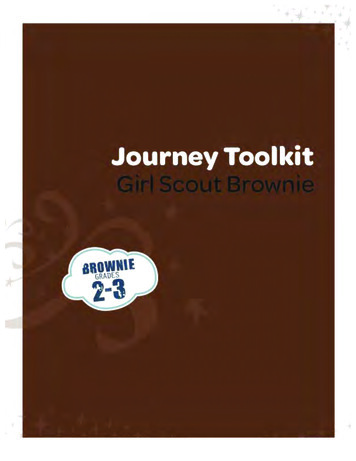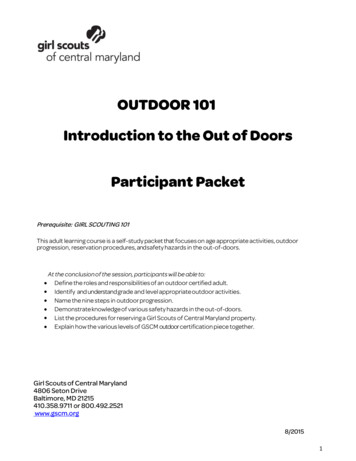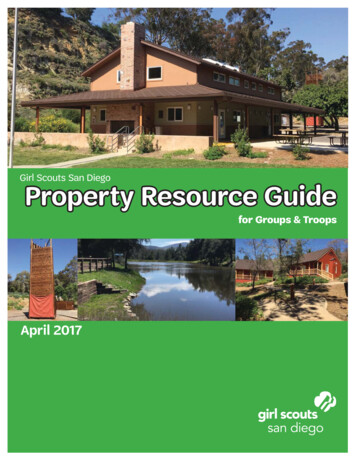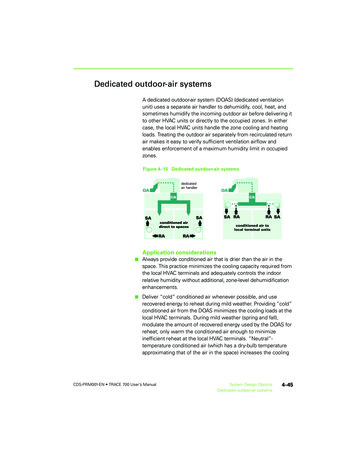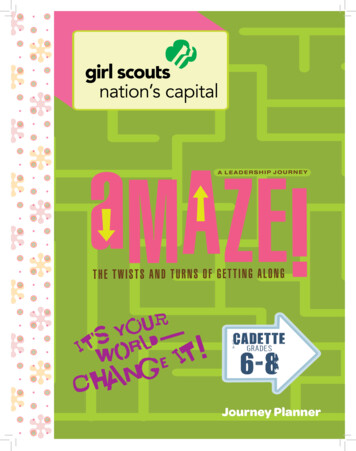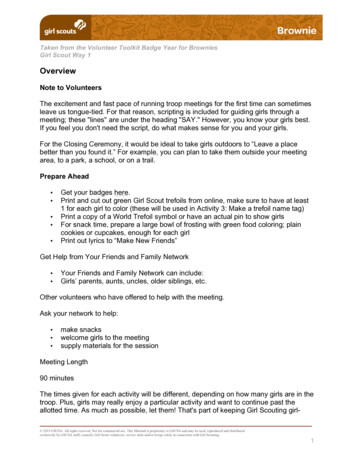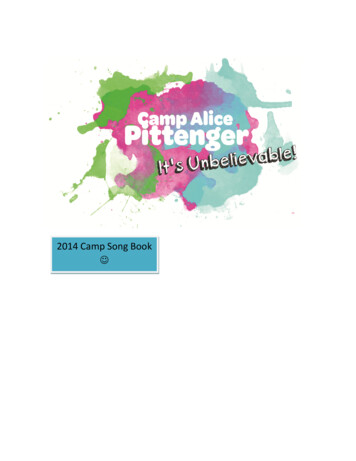
Transcription
OUTDOORCO O KINGGIRL SCOUTS HEART OF CENTRAL CALIFORNIAwww.girlscoutshcc.orgSACRAMENTO REGIONALPROGRA M CE NTE R6601 Elvas Avenue Sacramento, CA 95819916.452.9181 800.322.4475 f. 916.452.9182MODESTO REGIONAL OFFICE5172 Kiernan Court, Suite D, Salida, CA 95368209.545.3620 800.834.9899 f. 209.545.3621This publication is provided as a service of Girl Scouts Heart of Central California,which is supported by council product programs, grants, contributions and bequests.3/14
Girl Scouts Heart of Central CaliforniaOutdoor CookingTABLE OF CONTENTSForward . 1Planning . 2Leave No Trace Cooking . 4Solar Cooking. 5Using a Box Oven. 11Nutritional Information . 15Camp Kitchen Hygiene .16Meal Planning Tools .18Recipes . 25Make Ahead Snacks . 26Stove Top Meals . 31The One-Liners . 36One Pot Master Plans . 38Salad Ideas . 39Stove Top Desserts . 40Other Desserts . 42Box Oven Baking . 43Dutch Oven Information . 44Solar Cooking Recipes . 52Resources . 53
– FORWARD –“Out-of-doors activities provide wonderful opportunities for girls to make healthy choices. Even girlswho find regular exercise unbearable can enjoy a few hours hiking and exploring a park or wildernessarea and everyone will return for dinner with a hefty appetite. Young girls today are bombarded witha message that “thin is in.” Eating disorders are more prevalent now than ever before. Watch forextreme eating behaviors and talk with the girls about what they see as the ideal body type. Tell themthat extreme dieting will result in weight loss, but maybe at the expense of their muscles, bones andteeth. Weight control is best achieved by a combination of exercise and healthy food choices. Afourth grade Junior Girl Scout can expend more than 400 calories on a two hour day hike. Whatbetter excuse is there for trailside snacks and a hearty dinner? Enjoy!”Jane Heinig, Ph.D.Department of NutritionUniversity of California Davis1
PLANNINGThis outdoor cooking manual may be used for troop camping, service unit camporees, or daycamps. Here are some things to consider when planning an outdoor cooking experience Why plan meals for an outing? Safety and Comfort – People can go more than a week without food, vitamins or minerals, butwhy would you want to? Low energy intake can result in premature exhaustion and a chance of hypothermia. Constant energy intake keeps the mind and body working properly and keeps the individual alert.DIVERSITYGirl Scouting is a marvelous mixture of peoples with different ethnic, religious and culturalbackgrounds. Food provides all kinds of opportunities for helping children to appreciate thediversity around them. Consider introducing new foods from around the world or around thecorner!! Be sensitive to special diets and preferences.GETTING STARTEDAsk the girls to read and talk about good food planning. Consider nutrition and be sure to use all thefood groups. Is simplicity of preparation desired? Do girls want to learn new methods of cooking?You want to try new dishes? Consider the cost, altitude, equipment to rent or borrow or make. AreTry-its, badges or interest project requirements to be considered?Try any new foods at a troop meeting. On the camping trip is NOT the place to experiment withsomething new! Keep in mind that energy requirements are approximately 3,000-5,000 calories perday for high mountain adventure.BUDGETINGPlan meals that fit into the budget for your outdoor adventure. Talk with the girls about the budgetbefore you plan the menus. If you are traveling, be sure to have some money in your contingencyfund for unexpected food purchases.TIMINGCooking outdoors is a program that might take a lot of time, usually more than you planned for. Justgetting a charcoal fire started and coals ready for cooking is a 1/2 hour project. Cleanup can take asmuch as an hour. Try to match the time needed for preparation, cooking, eating and cleaning withthe other activities that the girls have selected. You can adjust your menus to fit time frames, theabilities of the girls and activity plans. Avoid getting so involved in cooking that you have no time forall the other exciting things the out-of-doors can offer. Take short cuts when you can. Not everythinghas to be prepared outdoors. For example, you can pre-cook foods which require long cookingtimes and bring them along. (Be sure to store them properly and keep cold if necessary). Wash, peel,slice and dice fruits and vegetables, store them in a ziplock bag. Pre-packaging spices or dryingredients for a recipe can be a tremendous timesaver.2
SHOPPINGYou can use a recipe wheel if more or fewer servings of a recipe are needed. The recipe wheel cansave time in planning for exact quantities. Recipe wheels can be found in most stores that specializein cookware.Make a shopping list. Bring along a menu so you will know how each item is used and when it is beingused. Ask for a discount (check with store ahead of time). Shop at discount food stores and use dayold or budget bakeries.AT HOMEMeasure and pack for specific recipes. Be sure to include directions. Count and package things forcertain meals. Wash, cut, peel, and wrap vegetables, form, season, and freeze hamburger patties.Precook, season, and freeze stew meat, chicken, etc. Freeze stews, casseroles, etc. in metal coffeecans or number 10 size cans and heat in cans at camp site.PACKINGUse apple boxes or other sturdy containers. Pack by the meal and mark tops of boxes with contents.Freeze all your own ice in handy sizes, milk cartons, plastic bottles, containers for water whenmelted.AT THE SITEPost kaper charts, menus, recipes. Have adequate utensils stored in clean, dry place. Have thecooks and helpers wash their hands before preparing any food.FUELOne of the challenges in today's world is to provide plenty of nutritious food and use a minimumamount of fuel in doing so. The days of unlimited wood supplies are gone. Did they ever really exist?In planning, be efficient with your use of fuel (propane or charcoal). Often seven or eight charcoalbriquettes will do just as well as twenty. Be sure to get dishwater on early so you don't use more fuelthan is necessary. And remember, cold meals can be just as nutritious as hot ones and a lot faster toprepare!SERVINGEncourage girls to try new things. Match serving size to size of girl. Beginning cooks thrive onencouragement. Help the girls to keep a positive attitude about the finished product.CLEAN UPPut dish water on EARLY. (Make sure there is a designated person). Have soapy water HOT. Disposeof garbage and trash and used water PROPERLY. Have an area for recyclable materials. Look atgarbage to see what was eaten; this will help you evaluate success of the menu.3
LEAVE NO TRACE COOKING“FUEL” FOR THOUGHTIn many locations, wood fires are prohibited. Today’s Girl Scouts are encouraged to use solar ovens,portable stoves, or charcoal. When working on your menu, consider the impact your outdoorcooking experience will have on the environment around you. Select a cooking method that will allowfor plenty of time for other activities and will Leave No Trace on the environment.SOME SAFETY BASICS FOR ALL OUTDOOR COOKINGMake or collect all your equipment before you start. Choose a recipe and read it thoroughly. Be sureyou have everything you need. Tie back long hair and roll up loose or floppy sleeves. When decidingwhere to cook, look for dirt, concrete, or asphalt. Heat can damage grass or wooden decks. Look up.Check for overhanging branches or buildings. Heat rises.AN IMPORTANT MESSAGELet the girls do the cooking! If you have taught cooking skills and safety, gone over each recipe andhave assigned specific responsibilities, they can do it! Yes, it takes longer. Yes, it may be a flop. Yes,you already know how to do it and want to help. But, it is their activity. No one will starve. The girls willnot learn to cook if you don’t let them. One adult should work with the cooks, and another adultshould be with the other girls away from the cooking area.COOKING METHODSAllow time for the girls to develop the skills needed. Be aware that altitude and weather can effectyour cooking methods and time.METHODSHEAT SOURCELess time to prepareFirelessRehydrationStick cookery* - toasting and roastingOne pot/skilletSteaming, boiling, grilling, barbecuingBakingMore time to prepare no heat neededstove, charcoal, woodcharcoal, woodstove, charcoal, woodstove, charcoal, woodsolar, stove, charcoal, woodUse coat hangers or stainless steel skewers with protected handles. Before using a hanger forcooking, be sure to burn off the coating on the end where food will be placed. To protect thehandles you can use a potholder or bandana.USING FOILFoil dinners cooked in wood or charcoal coals have been an outdoor cooking favorite. Stop andthink, is this a wise use of a non-reusable resource? Why not try cooking foods in skins (banana,orange), leaves (grape) or corn husks? Instead of over the campfire, use charcoal or a portablecamping stove.4
SOLAR COOKINGSolar cooking is a cutting edge technology that uses the power of the sun to cook. It is a Leave NoTrace technique that is well suited for outdoor troop experiences. Solar cookers come in two types:box ovens and panel cookers. For the troop on the go, the solar panels are the most portable andconvenient to use. And with all solar cookers no stirring is needed, enabling you to do other thingswhile the food cooks!Important things to remember about any solar cooker are:– use dark colored pots with lids – solar cookers can be used to cook and bake a wide variety of foods – it doesn’t need to be ‘hot’ outside, only consistently sunny – you will need to plan ahead — cooking in a solar cooker takes more time than othermethods For more information about solar cooking — including recipe books and patterns to build cookers —you can contact:Solar Cookers International1919 21st StreetSacramento, CA 95814916/455-4499www.solarcookers.orgYou will quickly learn that many things can be cooked in a solar cooker. Just remember to get thefood on early, don’t worry about overcooking. Use a thermometer. Unglazed tiles will help to hold theheat. You need to be aware of the local temperature to make sure that the sun will be ample to cookall food thoroughly.As a guide, foods can be classified as easy, medium or hard to cook. The normal amount of waterand seasoning are added to dried grains and beans. Water does not need to be added to freshvegetables such as carrots, potatoes, beets, and squash.EASY TO COOK FOODSTime: 2 hoursMEDIUM TO COOK FOODSTime: 3 hoursHARD TO COOK FOODSTime: 4-5 hourswhite esbulgur wheatpotatoeslentilsbrown ricedried corn (to make into masa)blackeyed beanslarge amounts of easy to cookfoods.pinto beansred beansblack beanskidney beanssplit green peasgarbanzo beanslarge amounts of medium to cookfoods.Cookbooks available for solar cooking include:“Eleanor’s Solar Cookbook.” Cemese Publishers, 7028 Leesburg place, Stockton, CA 95207.“Favorite Recipes from Solar Cooks.” Sacramento Metropolitan Utility District (SMUD),6201 S Street, Box 15830, Sacramento, CA 95852.– “Solar Cooking Naturally.” Sunlight Energy, 745 Mountain Shadows Drive, Sedona, AZ 89336.––5
The Bernard Solar Panel CookerA simple, portable model that may open new horizonsIt is generally assumed that a solar cooker should have some minimal capacity in order to workproperly. For instance, in the booklet Your Own Solar Box, SBCI recommends an inner box atleast 45 cm X 55 cm (18 X 22). The result is a rather large box, well suited to family use, butwhich can prove unnecessarily cumbersome in some cases.Smaller cookers would be appreciated by the following: People living or traveling alonePeople living with their family but needing a special dietElderly people who feel reluctant to carry a heavy boxTeenagers wishing to build and experiment with their own first cookerIf you belong to one of these categories, here is how you can build a cheap and fairly efficientsmall cooker.Choose a cardboard box (figure1) with the height BC greater than the width DC. For example,in my own cooker BC 30 cm (about 12”), DC 23 cm (9”), and CG 25 cm (10”).Cut the flaps off the box. Then cut the seams along FG and GC. Do the same on the other sidealong EH and HD. The carton folds out to a flat assembly of five rectangles as shown in figure 2(Letters appearing twice on this figure indicate two points which were the same point beforecutting). If the cardboard is thin, reinforce the rectangle CDHG by gluing another rectangularpiece of cardboard onto it to better insulate the bottom of the pot. Then glue aluminum foil toone side of the five rectangles (the inside of the original box).Now, keeping the rectangle CDHG horizontal on a table or on level ground, position the otherrectangles as shown in figure 3. The front “mirror” EFGH is tilted about 30 degrees above the6
horizontal plane (Put a rock or other object under it). The “wing mirrors” BFGC and AEHD arevertical, the angles GCG and HDH being about 45 degrees. A few rocks will be helpful,especially in windy weather.The black cooking pot is put on the horizontal base CDHG and covered with a colorless glasssalad bowl (or cooking bag) replacing the glass window of a classical box cooker. To avoidconvective heat losses, the diameter of the salad bowl should not exceed the width CD.A more convenient way of keeping the reflective system in good shape is to mount the panelson a wooden board in which you will drive a few nails on each side of GC and HD to maintainthe wing mirrors in their correct position (see figure 5).Although this cooker uses (slightly) concentrated sunlight, it is not necessary to worry about aconstant tracking of the sun.OBSERVED COOKING TIMESPotatoesCarrots2 eggsLentilsWhite riceBrown riceRed beans(300 grams 1 spoonful water)(250 grams 1 onion, no water)(1 spoonful water)(100 grams 250 grams water)(80 grams 160 grams water)(80 grams 160 grams water)(100 grams 200 grams water)7450 grams 1 pound2 hours2 hours1 hour1 hour 30 minutes1 hour 15 minutes2 hours2 hours 30 minutes
Instruction for Solar Panel CookerGirl Scouts Heart of Central California I 6601 Elvas Avenue Sacramento, CA 95819 I www.girlscoutshcc.orgEach person will need: 1 cardboard box – minimum size 12 inches high x 9 inches wide x 10 inches deepNo matter what the size of the box, the height needs to be greater thanthe width.3 large nailsgluescissors1 inch or 2 inch wide paint brushes (for glue)stringaluminum foil to cover inside of boxTo use the solar panels the following supplies are needed: oven temperature gauge – one per pot useddark enamel pots or dark glass baking ware1 turkey size oven roasting bag – one per pot usedTips for your solar panel cooker: Attach the string to the sides of the box and then nail into the ground or attach to somethingso that the sides don’t flap or fall down in the wind. If you forget the string, use rocks to propopen the sides. Place the pot inside the turkey roasting bag, then place a temperature gauge on top of thepot and blow up the bag to create an oven effect. Twist tie closed. Place the bag and stockpot on top of three rocks so that the bottom of the pot will also cook.It creates a convection oven type of effect by allowing the heat to circulate under the pot. Tip the front panel up to about a 30 degree angle. You may have to keep moving the panel cooker so that the sun will hit most of the panels asdirectly as possible Lastly, don’t keep checking to see if it’s done. It will work and the food will be finishedaccording to cooking times. If you keep checking you are letting out the heat and it will takeforever to cook.#4516 – rev – 2/14 – LW:js8
The SunAvailable and Free!When experienced solar cooks are asked what they consider the biggest advantage of solar cooking, mostreply, “It saves money!”Other advantages mentioned are: Pots do not need scrubbing, inside or outMuch time is saved for other activitiesTheir daughters have time to go to schoolFood never burnsNo smoky flavorNo smoke in their eyesNo coughing from the smokeSlow-cooking, protein rich foods are once more part of their family’s dietThe cooker can be carried to provide a hot lunch anywhereSome times the sun doesn’t shine, making solar cooking impossible – at night or when it rains, for example.Solar cooking is not always a replacement for other methods. To make the biggest difference in your fuelcosts, health, and time use the Integrated Cooking Method: A solar cooker when the sun is shiningA fuel-efficient stove when there is no sunA hay box in which to finish cooking started on either of the other two devicesThis can save as much as 75% of a family’s fuel costs.To determine if your food will cook:Stand with your back to the sun and look at your shadow. If it is much longer than you are tall, this is the wrongtime of year or the wrong time of day for your area, and some food may not cook well. However, the cookermay get hot enough to pasteurize water or cook thin foods like flat breads, cookies or thin slices of meat.Cheese melts at low temperatures.Some people think food will spoil if it is cooked slowly. This illustration shows that most germs that cause foodto spoil are killed long before reaching cooking temperature. It is important to remember that germs can be aproblem if cooked food is allowed to stand at room temperature a long time before it is eaten.9
STOVESWhen selecting a stove, consider the following: Is the stove cooking capacity appropriate for the number of people to be fed?Is the stove stable when a pot is placed on the burner?Is the stove designed for easy assembly, easy cleaning? Will it start without priming?Does the fuel tank stay cool when the stove is lit?Will the stove function at the altitude and in the weather where it will be used?CHARCOALAll charcoal is not alike. Some brands may not catch as quickly, or burn as hot as other brands.Tin can chimneys are highly recommended for starting charcoal fires.Charcoal, like other fuels, needs air to burn. A ready-made charcoal stove in a park or backyard hasbeen designed to enhance air flow. If you are making your own charcoal stove, construct it so that adraft of air flows past the charcoal.When extinguishing a charcoal fire, soak thoroughly with water. Lay the charcoal out to dry for reuse.Put the charcoal in a tin can with a tight cover and take it with you. If not taking the charcoal with you,make sure to crush each piece of charcoal with a rock to ensure that the coals are completelyextinguished.10
USING A BOX OVENSupplies: A box oven Four 6 ounce all metal juice cans – empty(or one soup sized 11 ounce can empty, with thelabel torn off) a small rack from a baking pan foil tongs and potholders hot charcoal a stick or a pencil a small rockChoose a flat area. Look for bare dirt, concrete, or asphalt. Heat can damage grass or woodendecks.1) Cover the spot selected with a sheet or two of foil – shiny side up. The foil helps reflectthe heat up into the food, and keeps the area clean. If it is windy, place rocks on thecorners of the foil to anchor it.2) Set the four metal cans in a square in the middle of the foil. These are used to hold up thefood on a rack, so heat can flow under and all around the food. If you are using just onecan, you can set it in the center of the foil.3) Set the oven down over the cans, and carefully draw around it with a pencil or a stick. Themark will show you where the box sits.4) Remove the box and use tongs to line up the hot charcoal briquette just inside the outlineof the box on all four sides. You will need one charcoal briquette for every 40 degrees oftemperature, with one extra for good measure. (To find out how many briquettes to use,divide 40 into the temperature desired. If the division does not come out even, use oneextra briquette.)5) Set the box down gently on its outline. None of the charcoal should touch the box. Usethe stick to push any briquettes that are too close.6) Slide the rock under one edge of the oven to lift it slightly off the ground. Charcoal musthave some fresh air to be able to burn.7) Let the oven heat for two or three minutes. Then gently lift it and set it aside to get thefood.8) Place the food to be cooked on the rack and replace the oven over it.About the same time is needed to bake something in a box oven as in a regular oven. If the recipecalls for twenty minutes, wait twenty minutes before peeking. If the food is not quite done, place theoven and the pebble back down, and give it a little longer. If your recipe takes longer than 45minutes, you will need to add more hot charcoal to what is in the oven already. Start the newcharcoal heating when you begin baking, and it will be ready when you need it. Just lift the box and11
use the tongs to add the charcoal.STARTING CHARCOALThe easiest and safest way to light the charcoal is using a fire starter and a charcoal chimney.Fire Starters:You can purchase fire starters at camping supply stores, but it is more fun to make your own. Seefire starter’s page for instructions to make fire starters.CHARCOAL CHIMNEYCut out both ends out of a 1-3 pound coffee can. Using a drink can opener, make air holes aroundthe one end. Place a fire starter on a piece of foil and light it with a wooden match. Set the chimneyover it with the air holes at the bottom. Fill the chimney with the required number of charcoalbriquettes. White smoke will assure you that the charcoal is heating. Leave the chimney alone forabout 30 minutes until the top briquettes turn white. Use tongs to lift off the chimney and thecharcoal is ready. You can use the chimney over and over again; just use caution while it is hot.(Self lighting charcoal and charcoal lighter may be used, but there may be a gas/chemical odor withthese products).BAKING IN A BOX OVENA box oven can usually cook enough for a family or a patrol at one time. If you are cooking for morethan eight people, you might want to use more than one oven. This will depend on the recipe andwhether you want to serve a small snack or a whole dinner. Anything that you would bake in your ownconventional oven can be made in the box oven. Experiment with your favorite recipes.12
CARDBOARD BOX OVENThis is an inexpensive, portable oven that will bake just like your oven at home. It is fun to make also!Materials:Accessories:Sturdy Cardboard Box (approx. 12 x 13 x 15)Heavy-Duty FoilScissors or Knife (for cutting box)Duct TapeSilver Tape (optional)Oven Wrap (optional)Empty Cans or Foil Covered BricksPie PansThermometer (optional)Grill (optional)Construction:Cut the top off the box. The box should allow about 1 inch of space around the baking pan.Cover the box and lid with foil, shiny side out.Cover all outside seams with duct tape (heat-resistant) to keep the heat from leaking out. If you wish to usetape on the inside of the box, use silver tape.On both sides of the box, near the bottom, cut or punch out holes (see diagram) about 1/4 inch in diameter.The coals need oxygen to burn.Optional: Punch a small hole in the back of the oven, high in one corner for insertion of the thermometer.Attach the foil-covered top, removed earlier, to serve as a door.Optional: If you want a window in the oven door, cut a square hole in the door and cover it with see-throughoven wrap. Tape it in place.Instructions for Use:Heat coals in a charcoal chimney. Place heated coals in a pie pan at the bottom of the oven. Each briquettesupplies 40 degrees of heat (a 360 degree temperature will take 9 briquettes).Use foil covered bricks and cans to hold the baking pan above the coals. The size of the cans will determinehow close the baking pan sits over the coals. Use taller cans (up to 10 inches high) for baking and shorter cansfor meat and casseroles. A grill or rack may also be used.The coals will hold heat for about an hour. For longer cooking times, add coals gradually while the originalcoals are still hot.13
WOOD FIRESSmall is better, build fires that are just large enough to serve the need and to make thrifty use ofwood. Make sure campfires are allowed, and be sure and get a fire permit as required. Alwayspractice fire safety including having a large bucket of water near the fire. Use only down, dead wood.When building a fire, remember to build in an established fire ring or on sand, rocks, or dirt. Neverbuild a fire at the base of a tree or near enough for heat to kill the roots. Ground should be cleared ofleaves, grass, sticks, etc., down to mineral soil and from an area large enough to prevent surroundingvegetation from lighting or smoldering underground.Build a fire with the wind at your back, as you face the fire. This will make a draft that blows throughthe fire when it is lighted.Fire StartersYou may use fire starters such as paraffin, sawdust, or trench candles in place of kindling to startcampfire or charcoal.PARAFFIN - SAWDUSTFill cardboard egg cartons half-full of sawdust or wood shavings. Melt paraffin or old candlesin a can placed over hot water (double boiler). Do no place can directly on the heat, becausethe paraffin will get very hot and may catch fire. Wax should be poured under adultsupervision. Pour melted paraffin or candle ends into each compartment until each space isfull. When cool, break apart each “egg” or store the whole carton for future use. Place one“egg” in the kindling and light a match.TRENCH CANDLESRoll several sheets of newspaper into a long, tight roll. Tie the roll with string at 2 1/2 inchintervals. Leave a three inch end on each string for dipping. Cut the roll between the strings.Dip each trench candle into a container of melted wax. Hang by the strings to dry.When you are finished with the fire, be sure it is out. Let the fire die down, stir, sprinkle with waterthen stir again. Repeat until there are no live coals. When you can press your hand on the spot wherethe fire was, you know it is out. If your fire was not built in an existing fire ring, grind all pieces topowder and scatter. Return the site to how it appeared before the fire was built, removing the rockfire ring and scattering all ash.14
Nutritional InformationEnergy requirements for high adventure are approximately 3,000-5,000 calories per day. Thecalorie intake is about 1 1/2 to 2 pounds per day per person. Assess your expected energy use. Foodshould be nutritionally balanced at approximately: 50% Carbohydrates25% Fats25% ProteinCarbohydrates: Are almost pure energy Are easy to digest Release their energy in minutesCarbohydrates come from: Starches Cereal Honey Fruit Nuts CandyUnfortunately their energy is almost consumed in about an hour. You would need to eatcontinuously if you only ate carbohydrates. During cold and wet weather, continuously stoke up oncarbohydrates to insure a steady supply of energy.Protein is somewhat more difficult to digest and doe
This publication is provided as a service of Girl Scouts Heart of Central California, which is supported by council product programs, grants, contributions and bequests. OUTDOOR C OOKING SACRAMENTO REGIONAL PROGRAM CENTER 6601 Elvas Avenue Sacramento, CA 95819 916.452.9181 800.322.4475 f. 916.452.9182 GIRL SCOUTS HEART OF CENTRAL CALIFORNIA


